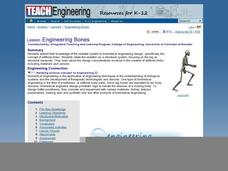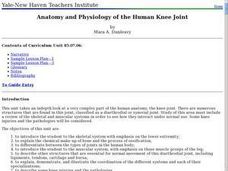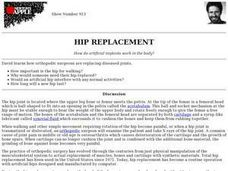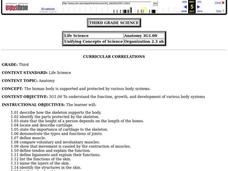Curated OER
Human Machine
Students explore the human body by conducting an exercise in class. In this human anatomy lesson, students view a diagram of the human body and identify the specific bones and joints that allow us to perform specific exercises like...
Curated OER
Engineering Bones
Students identify the features of a prosthetic limb and explain how engineers are involved in the prosthetic design. In this bone engineering lesson students describe the design criteria that goes into choosing the materials that go...
Curated OER
Anatomy and Physiology of the Human Knee Joint
Students examine human anatomy with a focus on the knee joint. In groups, they research the chemical makeup of human bones and explain the different types of joints found in the body. To end the lesson, they identify the other structures...
Curated OER
Levers and Wedges in the Human Body
Young biologists identify parts of the body that serve as wedges (teeth and fingernails), and as levers (jaw, arms, and legs). The hands-on activities described here should be exciting for learners to perform, and should also lead to a...
Curated OER
Hip Replacement
Students take a close examine animals' skeletons to see how their pelvis and femur work together for movement. By investigating their skeletons students discover the placement and functions of our own bodies. They use owl pellets in this...
Curated OER
Skeletal System
Third graders describe and identify the parts of the skeleton and how they support the body. They observe two chicken bones that have been soaked in vinegar for 5 - 7 days. They observe the bone's appearance after it has been removed...
Curated OER
The Skeletal System
Students identify bones off a skeleton during quizzes; assemble disarticulated skeletons; bird, frog and rat. They dissect frogs, remove the muscle tissue, and identify of bones.
Curated OER
Skeletal System
Seventh graders explore the functions of the skeletal system. They collaborate in small groups to determine the function of the skeletal system, the types of joints and movement, bone strength and growth, and bone injuries including...
Curated OER
"I can move" but why?
Students analyze the movements they can do with their bones, muscles and joints. They explore, have discovery and review knowledge of movement. Students are asked to find their personal space.
Curated OER
The Greatest Show on Earth: The World's Smallest Animals
Students create instruments to capture different types of insects. In this The Greatest Show on Earth: The World's Smallest Animals lesson, students compare the attributes of certain insects and record the data on a chart. After catching...
Curated OER
Invent an Insect
Explore biology by researching adaptation. First, learners research and define a list of insect vocabulary terms and discuss the benefits of each insect characteristic. They then utilize a worksheet to create their own insect and share...
Curated OER
What Can We Learn From Bones?
Students discuss what type of information they can gather from bones. In groups, they travel between stations in which they can view photos and listen to actual accounts of finding bones. They focus on the tools available to Native...
Curated OER
Diversity And Adaptations Of Organisms
Seventh graders demonstrate the processes of science by posing questions and investigating phenomena through language, methods and instruments of science. They study the body features or systems of several animals.














